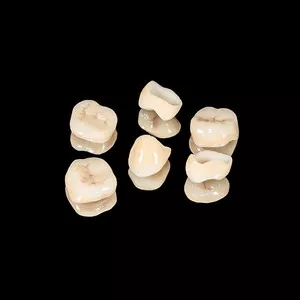The art and science of smiling

In today's society, a confident smile is an important sign of personal charm and self-esteem. However, some people feel insecure due to dental problems, which can affect their self-confidence and social life. For those looking to improve the appearance of their teeth and restore their confidence, advanced crowns and bridges offer a perfect solution. The development of these technologies draws on knowledge from art and science to make the perfect smile possible.
1. Advanced technology and production process
Crowns and bridges are treatments that restore and beautify teeth by restoring their shape, color, and function. Advanced technology allows dentists to customize crowns and bridges to each patient's specific needs to ensure optimal appearance and comfort. The production process usually includes the following steps:
1. Tooth preparation: The dentist will remove a small portion of the surface structure of the tooth so that the crown or bridge can fit snugly.
2. Print or scan: By printing an impression of the patient’s mouth or utilizing 3D scanning technology, the dentist can obtain the precise shape and size of the teeth.
3. Fabrication and customization: Using computer-aided design (CAD) and computer-aided manufacturing (CAM) technology, dentists can create crowns or bridges in the laboratory that meet the patient's needs.
4. Fitting and Adjustment: Once the crown or bridge is made, the dentist will secure it to the patient's teeth and make any necessary minor adjustments to ensure a perfect fit.
2. Material selection for crowns and bridges
Material selection for crowns and bridges is critical to their appearance and durability. The following are several materials currently commonly used:
1. Metal Alloys: Metal alloy crowns and bridges offer excellent durability and strength and are suitable for teeth that require greater support.
2. Porcelain: Porcelain crowns and bridges have a similar look and feel to natural teeth and are the most common and aesthetically pleasing option.
3. Ceramic synthetic resin: This material combines the advantages of porcelain and resin, and has better durability and aesthetics.
4. Pure porcelain/zirconia: These materials have excellent aesthetics and durability and are especially suitable for dental restorations in visible areas.
3. Oral aesthetics and personalized design
Dentists consider oral aesthetics and each patient's individual characteristics when designing crowns and bridges. By using color matching and custom shapes, dentists can ensure that restored teeth blend perfectly with your natural teeth, restoring functionality while also improving appearance.
4. Maintenance and Durability
The durability of crowns and bridges depends on proper maintenance and personal hygiene habits. Here are some suggestions:
1. Brush and floss regularly: Maintaining good oral hygiene habits can extend the life of dental crowns and bridges.
2. Avoid biting hard objects: Avoid biting hard objects to prevent damage to crowns and bridges.
3. Regular follow-up visits on time: Follow the dentist’s recommendations for regular follow-up visits to ensure the normal function of the crown and bridge.
Summarize
Smile Makeovers: The Art and Science Behind Advanced Dental Crowns and Bridges provides important solutions for people who want to improve the appearance of their teeth and regain their confidence. Drawing from art and science, advanced crown and bridge technology provides a personalized restoration solution for each individual. Choosing the right materials and correct maintenance habits can ensure the durability and beauty of crowns and bridges. By choosing the professional services and care of a dentist, you can achieve a perfect smile and a confident life.




